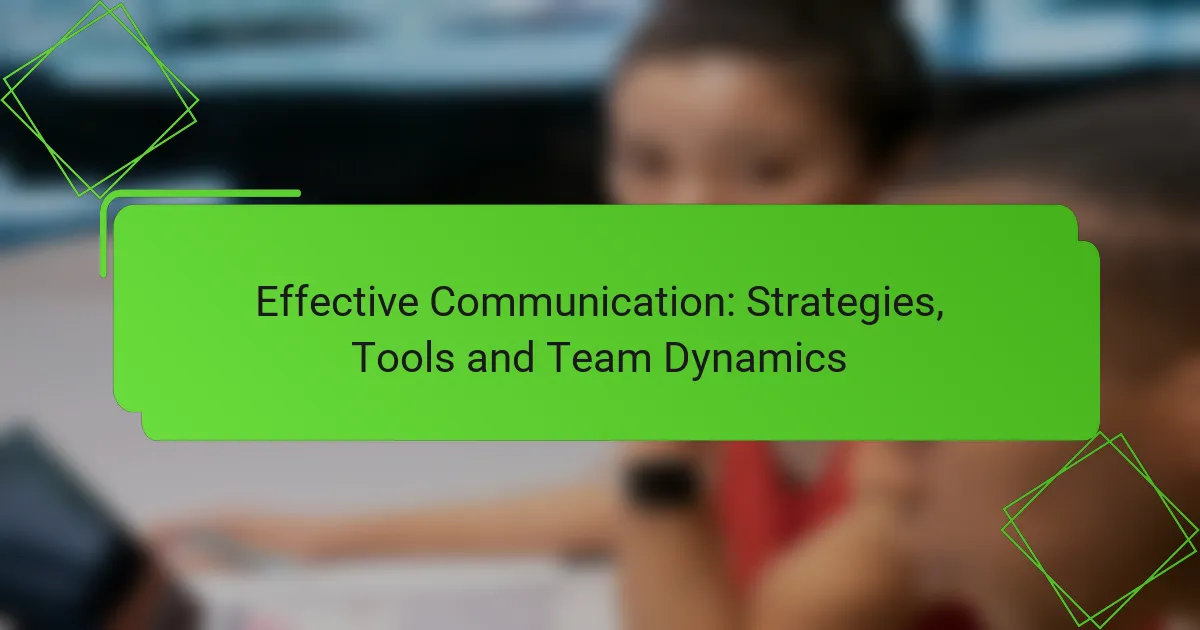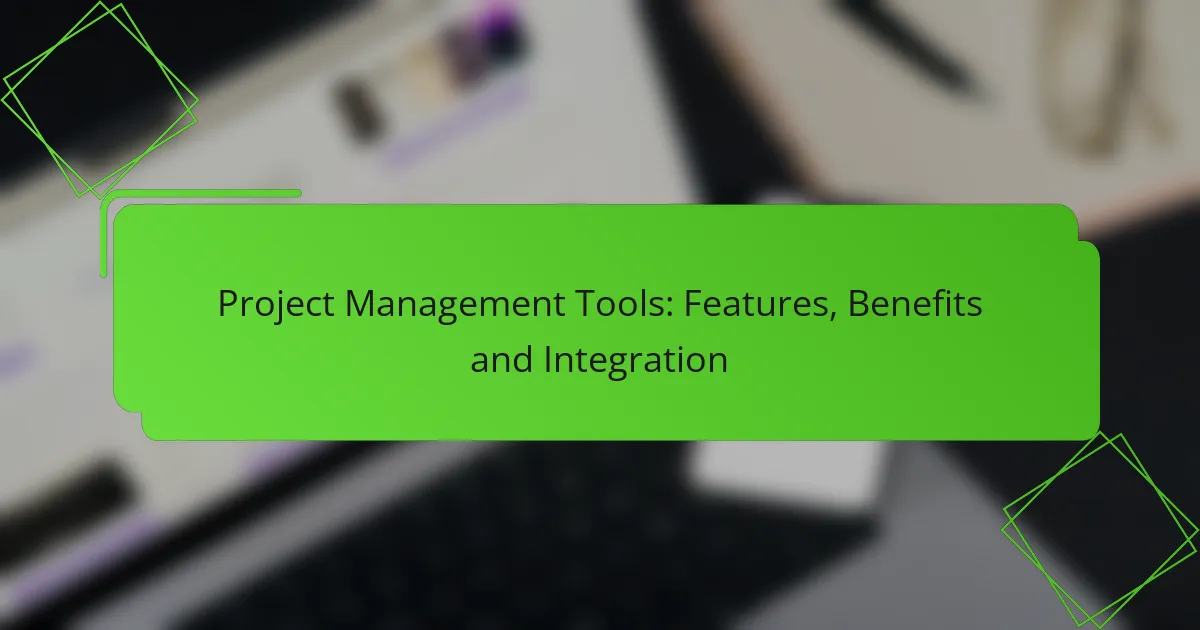Effective communication is essential for fostering collaboration and understanding within teams, particularly in dynamic environments like those in Ireland. By implementing targeted strategies and utilizing appropriate tools, teams can enhance their interactions and align more closely with their goals. Additionally, the dynamics among team members play a crucial role in shaping communication, influencing both the quality of dialogue and the overall productivity of the group.

What are effective communication strategies for teams in Ireland?
Effective communication strategies for teams in Ireland focus on fostering clarity, collaboration, and understanding among team members. These strategies enhance teamwork and ensure that everyone is aligned with the team’s goals and objectives.
Active listening techniques
Active listening is crucial for effective communication within teams. It involves fully concentrating, understanding, responding, and remembering what is being said. Techniques such as nodding, summarizing key points, and asking clarifying questions can significantly improve engagement and comprehension.
To practice active listening, team members should avoid interrupting and instead focus on the speaker’s message. This can lead to a more inclusive environment where everyone feels valued and heard.
Clear messaging frameworks
Clear messaging frameworks help ensure that information is conveyed in a straightforward manner. Utilizing models like the “5 Ws” (Who, What, When, Where, Why) can guide team members in structuring their messages effectively. This clarity minimizes misunderstandings and keeps everyone on the same page.
When creating messages, it’s essential to tailor the content to the audience. Using simple language and avoiding jargon can make communication more accessible, especially in diverse teams.
Feedback loops
Establishing feedback loops is vital for continuous improvement within teams. Regularly soliciting feedback allows team members to express their thoughts on processes and communication styles. This can be done through informal check-ins or structured surveys.
Encouraging a culture of constructive feedback helps identify areas for growth and reinforces positive behaviors. Teams should aim for a balance between giving and receiving feedback to foster mutual respect and development.
Non-verbal communication cues
Non-verbal communication cues, such as body language and facial expressions, play a significant role in how messages are interpreted. Being aware of these cues can enhance understanding and prevent miscommunication. For instance, maintaining eye contact can signal attentiveness and engagement.
Teams should be mindful of cultural differences in non-verbal communication, as gestures may have different meanings in Ireland compared to other countries. Training sessions on non-verbal cues can improve overall team dynamics.
Conflict resolution methods
Effective conflict resolution methods are essential for maintaining harmony within teams. Approaches like collaborative problem-solving encourage open dialogue and focus on finding mutually beneficial solutions. This can prevent conflicts from escalating and promote a positive team environment.
Teams should establish clear protocols for addressing conflicts, such as setting aside time for discussions and involving a neutral third party if necessary. Encouraging a culture of respect and understanding can help mitigate potential disputes before they arise.

How can tools enhance communication in teams?
Tools can significantly enhance communication in teams by streamlining interactions, improving collaboration, and ensuring that information is easily accessible. Utilizing the right tools can lead to increased productivity and a more cohesive team environment.
Collaboration platforms like Slack
Collaboration platforms such as Slack facilitate real-time communication among team members, allowing for instant messaging, file sharing, and channel organization. These features help teams stay connected, especially in remote or hybrid work settings.
To maximize the effectiveness of Slack, create dedicated channels for specific projects or topics. This keeps discussions organized and ensures that relevant information is easily retrievable.
Project management tools such as Trello
Project management tools like Trello help teams visualize tasks and track progress through boards and cards. This visual representation allows team members to see who is responsible for what and the status of various tasks at a glance.
When using Trello, consider setting deadlines and assigning tasks to specific team members. Regularly review the board in team meetings to ensure everyone is aligned and aware of their responsibilities.
Video conferencing solutions like Zoom
Video conferencing solutions such as Zoom enable face-to-face communication regardless of physical location, fostering stronger relationships among team members. Features like screen sharing and breakout rooms enhance collaboration during meetings.
To improve the effectiveness of Zoom meetings, establish a clear agenda beforehand and encourage participation from all members. Limit meetings to essential discussions to respect everyone’s time.
Document sharing services like Google Drive
Document sharing services like Google Drive allow teams to store, share, and collaborate on documents in real-time. This ensures that all team members have access to the latest information and can contribute simultaneously.
To make the most of Google Drive, organize files into clearly labeled folders and set appropriate sharing permissions. Regularly audit shared documents to keep the workspace tidy and relevant.

What role do team dynamics play in communication?
Team dynamics significantly influence communication by shaping how members interact, share information, and collaborate. Positive dynamics foster open dialogue and trust, while negative dynamics can hinder effective communication and lead to misunderstandings.
Trust-building activities
Trust-building activities are essential for enhancing communication within teams. These activities can range from team-building exercises to informal social gatherings, allowing members to connect on a personal level. Regularly engaging in such activities can create a foundation of trust that encourages open and honest communication.
Examples of effective trust-building activities include icebreaker games, collaborative problem-solving tasks, and team retreats. These initiatives help break down barriers and promote a sense of belonging among team members.
Role clarity and responsibilities
Clear roles and responsibilities are crucial for effective communication in any team. When team members understand their specific duties and how they contribute to the overall goals, it minimizes confusion and enhances collaboration. Regularly reviewing and clarifying roles can prevent overlaps and ensure accountability.
To establish role clarity, consider creating a responsibility assignment matrix (RACI) that outlines who is Responsible, Accountable, Consulted, and Informed for each task. This visual tool helps everyone understand their contributions and fosters smoother communication.
Diversity and inclusion impacts
Diversity and inclusion play a vital role in shaping team dynamics and communication. A diverse team brings varied perspectives, which can enhance problem-solving and creativity. However, it also requires intentional efforts to ensure that all voices are heard and valued.
To promote effective communication in diverse teams, establish inclusive practices such as encouraging participation from all members, actively seeking input from quieter individuals, and providing training on cultural competency. These strategies can help mitigate misunderstandings and foster a collaborative environment.

What criteria should be used to choose communication tools?
Choosing communication tools requires evaluating user-friendliness, integration capabilities, and cost-effectiveness. These criteria ensure that the tools enhance collaboration and meet the specific needs of your team.
User-friendliness
User-friendliness is crucial for ensuring that all team members can easily adopt and utilize the communication tools. Look for intuitive interfaces and straightforward navigation that minimize the learning curve. Tools that offer tutorials or customer support can also enhance user experience.
Consider conducting a trial period with potential tools to gauge how easily your team adapts. Feedback from team members can help identify any challenges or preferences that may influence the final decision.
Integration capabilities
Integration capabilities refer to how well a communication tool connects with other software your team uses. Tools that seamlessly integrate with project management, file sharing, and calendar applications can streamline workflows and reduce the need for switching between platforms.
Evaluate whether the tool supports APIs or has built-in integrations with popular services. This can significantly enhance productivity by allowing for automated updates and notifications across systems.
Cost-effectiveness
Cost-effectiveness involves assessing the pricing structure of communication tools in relation to their features and benefits. Look for tools that offer a good balance between affordability and functionality, considering both upfront costs and ongoing expenses.
Many tools provide tiered pricing based on team size or feature sets. It’s wise to compare these options and consider any hidden costs, such as additional fees for premium features or support. Aim for tools that fit within your budget while still meeting your team’s communication needs.



